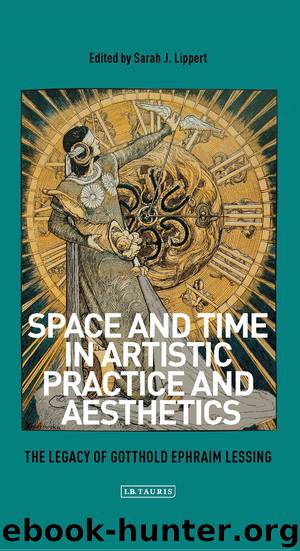Space and Time in Artistic Practice and Aesthetics by Sarah Lippert

Author:Sarah Lippert
Language: eng
Format: epub
Publisher: I.B.Tauris
Figure 5.2Willem de Kooning, Woman I, 1950–5, oil on canvas, 1.93 m x 1.47 m (75 x 58 in.), Museum of Modern Art, New York City, USA.
Photographic credit: Courtesy of the Museum of Modern Art.
The unequivocal subjectivity expressed in a body, such as shown in de Kooning’s woman or Soutine’s portrait, challenge the claims that art and art theory support unselfish, detached and aesthetic principles. Artists such as de Kooning pluralised and complicated the issue of abstract painting, by virtue of his ambiguous themes, which are part painterly abstraction and part image of figure. de Kooning’s statements alluded to the problems of theory and overreaching definitions saying that the ‘word “abstract” comes from the light tower of philosophers’.24 de Kooning’s damaged iconography abolished Greenberg’s association of abstract formalism and Immanuel Kant’s (1724–1804) unbiased, ‘disinterested’ aesthetic.25 Greenberg knew that an art completely divorced of subject matter appeared purposely misunderstood or completely subjective, and his insistence that abstract painting related to Kant’s notion of the ‘disinterested’ revealed the critic’s determination to anchor American art in the throes of traditional aesthetics, and to counter the individual pragmatism found in America. Greenberg admitted that Kant had ‘more insights into the nature of esthetic experience than anyone else’26 and, just as Greenberg borrowed Lessing’s historic medium-awareness in Laocoön, he championed Kant’s historic notion of the unbiased ‘disinterested’.27
For Kant, art and aesthetic judgement involved a union of pleasure and universal truth. In the late eighteenth century, whilst Lessing had broken ground for the importance of process, he still felt that art was primarily for personal pleasure, as stated in his Laocoön: ‘Truth is necessary for the soul; and it becomes tyranny to exert any force upon it in respect to this vital need. The ultimate end of the arts, however, is pleasure; and pleasure is dispensable’.28 Kant, on the other hand, placed aesthetic judgement and experience in a realm unto itself, and beyond personal pleasure, which offered profound implications for the significance of art. Published in his The Factor of Surprise (1975), Greenberg explained with erudite precision that the ‘Esthetic expectation is “unpractical”, disinterested, and it is so because it is created solely within esthetic experience by nothing outside it’.29 The reflexive idea of the ‘disinterested’ meshed perfectly with the reflexivity of the formalist aesthetic and in part resided in the context of universal beauty, which was thought to be an object that brought pleasure purely for its own sake. Yet, in his Critique of Judgment, Kant stated that ‘Taste is the faculty of judging an object or a mode of representation based on pleasure or aversion, yet without interest’.30 This contradiction between individual experience and unselfish universality plagued Greenberg as well. Whilst Kant resolved the contradiction with the complicated ‘subjective universality’, Greenberg rationalised the ‘disinterested’ aesthetic experience as being a key response to abstract art and the autonomy of process. And, in doing so, he situated the individual and experimental expression with the international advances of the avant-garde. He posited an individualist and democratic, but
Download
This site does not store any files on its server. We only index and link to content provided by other sites. Please contact the content providers to delete copyright contents if any and email us, we'll remove relevant links or contents immediately.
Aircraft Design of WWII: A Sketchbook by Lockheed Aircraft Corporation(32140)
The Great Music City by Andrea Baker(30797)
Call Me by Your Name by André Aciman(19929)
The Art of Boudoir Photography: How to Create Stunning Photographs of Women by Christa Meola(18414)
The Secret History by Donna Tartt(18220)
Shoot Sexy by Ryan Armbrust(17563)
Plagued by Fire by Paul Hendrickson(17119)
Portrait Mastery in Black & White: Learn the Signature Style of a Legendary Photographer by Tim Kelly(16877)
Adobe Camera Raw For Digital Photographers Only by Rob Sheppard(16805)
Photographically Speaking: A Deeper Look at Creating Stronger Images (Eva Spring's Library) by David duChemin(16504)
Ready Player One by Cline Ernest(14031)
Pimp by Iceberg Slim(13802)
Bombshells: Glamour Girls of a Lifetime by Sullivan Steve(13700)
The Goal (Off-Campus #4) by Elle Kennedy(13209)
Art Nude Photography Explained: How to Photograph and Understand Great Art Nude Images by Simon Walden(12858)
Kathy Andrews Collection by Kathy Andrews(11342)
The Priory of the Orange Tree by Samantha Shannon(8633)
Thirteen Reasons Why by Jay Asher(8470)
The remains of the day by Kazuo Ishiguro(8412)
